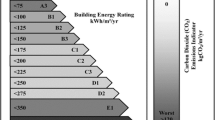Abstract
For buildings designed to meet aggressive energy goals, there is a need for tools to assist in the monitoring and maintenance of performance once the building is in operation. In particular, dashboard visualizations that show real-time and historic end use energy consumption alongside expected performance are powerful tools for both occupant engagement and the identification of operational issues. This article focuses on two related approaches to calculating upper and lower control limits for acceptable ranges of end use, which use a combination of modeled and measured usage data to generate realistic energy-conservative control limits. The first approach centers on the analysis of frequency distributions for end use consumption as functions of a main effect variable, while the second approach uses multivariate quantile regression based on principal components to generate control limits from all available measured variables.












Similar content being viewed by others
Abbreviations
- BIC:
-
Bayesian information criterion
- CSV:
-
Comma separated values file
- LCL:
-
Lower control limit
- LQM:
-
Lower quartile modeled
- LQO:
-
Lower quartile observed
- NREL:
-
National Renewable Energy Laboratory
- OLS:
-
Ordinary least squares
- PC:
-
Principal component
- PCA:
-
Principal component analysis
- PV:
-
Photovoltaic
- RSF:
-
Research Support Facility
- TMY3:
-
Typical Meteorological Year v3 weather data
- UCL:
-
Upper control limit
- UQM:
-
Upper quartile modeled
- UQO:
-
Upper quartile observed
- WE:
-
Weekend
- WD:
-
Weekday
References
Berkeley, Labs (2012). The energy information handbook: applications for energy-efficient buildings operations (http://eis.lbl.gov/downloads/energy-information-handbook.pdf)
Brown, Z.B., Cole, R.J. (2008). “Engaging occupants in green building performance; addressing the knowledge gap.” In Proceedings of the 2008 ACEEE summer study on energy efficiency in buildings. Monterey, Calif.
Capehart, B.L. & Middelkoop, T. (2011). Handbook of web based energy information and control systems, The Fairmont Press, ISBN-13: 978-1439876848.
Draper, N.R. & Smith, H. (1998). Applied regression analysis (3rd Edition). John Wiley, ISBN 0-471-17082-8.
Ehrhardt-Martinez, K., & Laitner, J. A. (2010). People centered initiatives for increasing energy savings. Washington: American Council for an Energy-Efficient Economy.
Gilchrist, W. (2000). Statistical modelling with quantile functions. Chapman & Hall, ISBN 1-58488-174-7.
Granderson, J., Piette, M. A., & Ghatikar, G. (2011). Building energy information systems: user case studies. Energy Efficiency, 4(1), 17–30.
Henryson, J., Håkansson,T., Pyrko, J. (2000). “Energy efficiency in buildings through information—Swedish perspective.” Energy Policy 28(3).
Johnson Controls (2015). “Energy Reporting and Dashboard Tool (EDART).” http://www.johnsoncontrols.sg/content/sg/en/products/building_efficiency/controls/building-management-systems/edart.html, retrieved February 11, 2015.
Jolliffe, I. T. (2002). Principal component analysis, series: Springer series in statistics (2nd edition). NY: Springer. ISBN 978-0-387-95442-4.
Koenker, R (2005). Quantile regression. Cambridge University Press. ISBN 0-521-60827-9.
Leach, M., Lobato, C., Hirsch, A., Pless, S., Torcellini, P. (2010). Technical support document: strategies for 50 % energy savings in large office buildings. 163 pp.; NREL Report No. TP-550-49213. http://www.nrel.gov/docs/fy10osti/49213.pdf.
Long, N., Scheib, J., Pless, S. (2013). “Using models to provide predicted ranges for building-human interfaces” In Proceedings of the 13th International Conference of the International Building Performance Simulation Association, 2013. Chambery, France.
Mahdavi, A., Mohammadi, A., Kabir, E., & Lambeva, L. (2008). Occupants’ operation of lighting and shading systems in office buildings. Journal of Building Performance Simulation, 1(1), 57–65.
Masoso, O. T., & Grobler, L. J. (2009). The dark side of occupants’ behaviour on building energy use. Energy and Buildings, 42, 173–177.
Pearson, K. (1895). Notes on regression and inheritance in the case of two parents. Proceedings of the Royal Society of London, 58, 240–242.
Peterson, J. E., Shunturov, V., Janda, K., Platt, G., & Weinberger, K. (2007). Dormitory residents reduce electricity consumption when exposed to real time visual feedback and incentives. International Journal of Sustainability in Higher Education, 8(1), 16–33.
Pless, S., Torcellini, P.A., Shelton, D. (2011). Using an energy performance based design-build process to procure a large scale low-energy building. Presented at ASHRAE Winter Conference, 2011. Preprint. 11 pp.; NREL Report No. CP-5500-51323. http://www.nrel.gov/docs/fy11osti/51323.pdf
Sartori, I., Napolitano, A., & Voss, K. (2012). Net zero energy buildings: a consistent definition framework. Energy and Buildings, 48, 220–232. doi:10.1016/j.enbuild.2012.01.032. ISSN 0378-7788.
Schott, M., Long, N., Scheib, J. (2012). “Progress on enabling an interactive conversation between commercial building occupants and their building to improve comfort and energy efficiency.” In Proceedings of the 2012 ACEEE summer study on energy efficiency in buildings. Monterey, Calif. http://www.aceee.org/files/proceedings/2012/data/papers/0193-000234.pdf
Schwarz, G. E. (1978). Estimating the dimension of a model. Annals of Statistics, 6(2), 461–464. doi:10.1214/aos/1176344136. MR 468014.
Shady Attia, S., Hamdy, M., O’Brien, W., & Carlucci, S. (2013). Assessing gaps and needs for integrating building performance optimization tools in net zero energy buildings design. Energy and Buildings, 60, 110–124. doi:10.1016/j.enbuild.2013.01.016. ISSN 0378-7788.
Siemens (2015). “Advantage navigator.” http://w3.usa.siemens.com/buildingtechnologies/us/en/energy-efficiency/advantage-navigator/pages/advantage-navigator.aspx, retrieved February 11, 2015.
Zeiler, W., van Houten, R., Kamphuis, R., Hommelberg, M. (2006). “Agent technology to improve building energy efficiency and occupant comfort.” In Proceedings of the sixth international conference for enhanced building operations.
Zeiler, W., Boxem, G., van Houten, R., van der Velden, J., Wortel, W., Kamphius, R. (2008). “Agent based modelling to improve comfort and save energy in the built environment.” In Proceedings of the computers and information in engineering conference: ASME 2008, Brooklyn, New York.
Author information
Authors and Affiliations
Corresponding author
Rights and permissions
About this article
Cite this article
Henze, G.P., Pless, S., Petersen, A. et al. Control limits for building energy end use based on frequency analysis and quantile regression. Energy Efficiency 8, 1077–1092 (2015). https://doi.org/10.1007/s12053-015-9342-6
Received:
Accepted:
Published:
Issue Date:
DOI: https://doi.org/10.1007/s12053-015-9342-6




